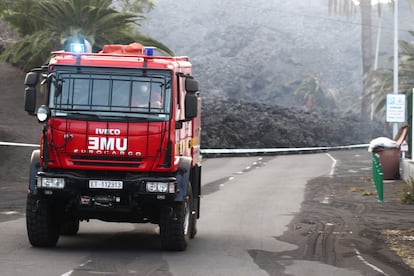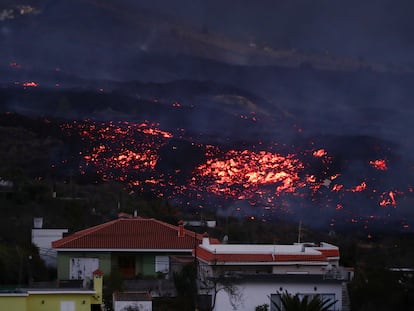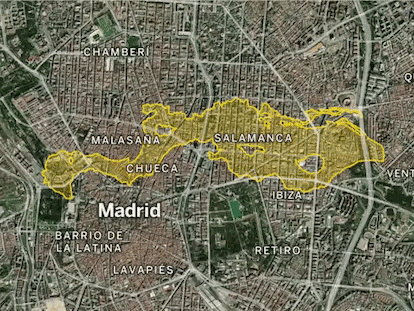New surge in lava flow fuels fears of further destruction in Spain’s La Palma
Another 300 people were evacuated after a wave of molten rock overflowed out of the volcanic cone

It has been 26 days since the Cumbre Vieja volcano on La Palma, in Spain’s Canary Islands, began to erupt, and there is still no sign the crisis is easing. The volcano is maintaining its destructive power and continues to spew out lava, so much so that on Thursday at 2.15pm, the magma coming out could not be contained by the volcanic cone. This led the lava to overflow in a great wave, as captured by images shared on Twitter by the Canaries Volcanology Institute (Involcan).
“It’s a common event due to the fluctuations in the flow of the lava in the main cone. Nothing to worry about for now,” assured sources from Involcan. “The normal thing is for these [lava flows] to end up reinserting themselves into the main flow,” explained sources from Spain’s National Geographic Institute (IGN).
The eruption is taking a toll on the municipality of Los Llanos de Aridane, which has seen three successive evacuation operations between Tuesday morning and Thursday. The main evacuation effort took place on Tuesday, when around 800 people in the center of La Laguna neighborhood were forced to leave their homes due to the approach of the lava. On Wednesday evening, authorities ordered the evacuation of another neighborhood, further to the east, a decision that affected around 100 people, according to the latest census data. And just 12 hours later, on Thursday morning, another 300 people were evacuated when the exclusion area was expanded to the west, up to the border of the municipality of Tazacorte.
Desborde de la colada de lava en el cono principal a las 14,15 hora canaria / Outflow on the lava flow at the main cone at 14,15 canarian time pic.twitter.com/X1S6Pupi8M
— INVOLCAN (@involcan) October 14, 2021
But many of these residents had already left their homes before the areas were evacuated, said Miguel Ángel Morcuende, the spokesperson of the Volcano Risk Prevention Plan (Pevolca), the team of experts monitoring the eruption. In just two days, 1,200 residents have left their homes, bringing the total number of displaced people to close to 7,000. Of this figure, just 238 have made use of the accommodation provided by the Canary Islands regional government in a hotel in Fuencaliente, in the south of the island. As of Thursday, the lava had affected 674.5 hectares, 34.2 more than the day before. “This is what happens with all the flows,” said Morcuende at a news conference. “They always surprise us with their behavior.”
The advance of the lava, however, is being closely guided by the terrain and the changes in the volcanic cone. One lava flow, classified by Pevolca as the primary one, has stopped moving. This river of molten rock reached the Montaña de Todoque, a mountain in the municipality of the same name, the first week after the eruption began, and moved south until it came into contact with the Atlantic Ocean, where it has created a lava platform measuring around 34 hectares.
Over time, however, a second stream of lava began to emerge from the primary flow around 200 meters to the south. This flow is likely to surround the Montaña de Todoque from the north, swallowing up everything in its path. Another flow stemming from the main one is moving in a west-northwest direction. This river of molten rock has split into two different channels, one of which on Thursday destroyed a warehouse used by the supermarket chain Spar. Northeast of this flow is another lava tongue that passed over the industrial area of El Callejón de la Gata earlier this week and is threatening new neighborhoods.

“This [lava stream] is the reason why we have had to evacuate all of La Laguna,” explained Morcuende. The advance of the lava has so far affected 1,634 buildings, 1,548 of which have been totally destroyed. Another 179.3 hectares of agricultural land, half of which is used for banana plantations, has also been swallowed up by the lava. The good news, according to Pevolca, is that the last two fronts “are losing the ability to move over land” as they drag more material along with them and become more viscous.
A scientific report from Pevolca classified the Cumbre Vieja as category 2 on the Volcanic Explosivity Index (VEI), a numeric scale that measures the relative explosivity of historic eruptions. Joan Marti, a volcanologist and head of the Geosciences Barcelona Group at Spain’s national research center CSIC, said that this scale oscillates between 0 for non-explosive eruptions and 8 for the biggest explosive eruptions on the geological registry.
The Cumbre Vieja volcano has spewed up ocean sediment pre-dating the formation of La Palma, according to Vicente Soler, a volcanologist from the CSIC. In a video shared on social media, Soler shows a sample taken from an area close to the center of the eruption which could be classified as “pre-island ocean sediment” – a conclusion that still needs to be confirmed in the lab.
Tu suscripción se está usando en otro dispositivo
¿Quieres añadir otro usuario a tu suscripción?
Si continúas leyendo en este dispositivo, no se podrá leer en el otro.
FlechaTu suscripción se está usando en otro dispositivo y solo puedes acceder a EL PAÍS desde un dispositivo a la vez.
Si quieres compartir tu cuenta, cambia tu suscripción a la modalidad Premium, así podrás añadir otro usuario. Cada uno accederá con su propia cuenta de email, lo que os permitirá personalizar vuestra experiencia en EL PAÍS.
¿Tienes una suscripción de empresa? Accede aquí para contratar más cuentas.
En el caso de no saber quién está usando tu cuenta, te recomendamos cambiar tu contraseña aquí.
Si decides continuar compartiendo tu cuenta, este mensaje se mostrará en tu dispositivo y en el de la otra persona que está usando tu cuenta de forma indefinida, afectando a tu experiencia de lectura. Puedes consultar aquí los términos y condiciones de la suscripción digital.
More information
Últimas noticias
Welcome to the post-religion era: The idea of Christianity as the absolute truth has become obsolete
‘I thought you would like it’: The risky sexual practice popularized by TV shows and TikTok
The digitalization of tourism: ‘They promise experiences and gave us the worst possible one’
Mexican peso defies uncertainty with forecasts of a new period of stability in 2026
Most viewed
- Sinaloa Cartel war is taking its toll on Los Chapitos
- Oona Chaplin: ‘I told James Cameron that I was living in a treehouse and starting a permaculture project with a friend’
- Reinhard Genzel, Nobel laureate in physics: ‘One-minute videos will never give you the truth’
- Why the price of coffee has skyrocketed: from Brazilian plantations to specialty coffee houses
- Silver prices are going crazy: This is what’s fueling the rally











































